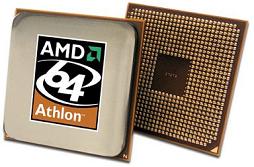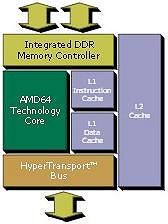AMD's Athlon 64 processor, released in September 2003, was their first 64-bit processor targeted for the workstation market to compete with Intel's Pentium 4. AMD's first 64-bit processor was the Opteron, released earlier in April that same year, targeted for the server market to compete with Intel's Xeon processor.

Initial Athlon 64's used the ClawHammer core which had a single-channel integrated 64-bit memory controller. Later Athlon 64's used the Venice or San Diego core which had an integrated dual-channel 128-bit memory controller.
Athlon 64's that used Socket 754 had the single-channel memory controller. Those that used Socket 939 had the dual-channel memory controller. Socket 754 Athlon 64's had a 800 MHz HyperTransport bus, while Socket 939 versions had a 1000 MHz HyperTransport bus.

• HyperTransport is a connection method that transfers data faster. On a motherboard, the HyperTransport bus connects the PCI slots, AGP slots and USB ports to the CPU and memory and also provides a connection between the CPU and memory.
All Athlon 64's have a 128KB L1 Cache (64KB for instructions and 64KB for data). The San Diego core is produced only for Socket 939 and doubled Venice's L2 cache from 512 KB to 1 MB and it features a 2000 MHz HyperTransport bus.
• AMD's Athlon 64 processors also come in X2 and FX versions, both of which have dual 64-bit cores, the FX versions have their multipliers unlocked for hardware hackers and gamers.
Athlon 64s are able to run 16-bit, 32-bit, and 64-bit code. There are two different modes that the processor can run in: "Legacy mode" and "long mode". Legacy mode runs 16-bit and 32-bit programs natively. Long mode runs 64-bit programs natively, but also allows for 32-bit programs to run inside a 64-bit operating system.
Athlon 64's integrated memory controller supports PC3200, PC2700, PC2100, or PC1600 DDR SDRAM.
Athlon 64's support MMX, 3DNow!, SSE, SSE2, and SSE3. These are all extensions to the instruction set for enhanced multimedia. The first ones, "MMX" stands for MultiMedia eXtensions. 3DNow! is a set of 21 new instructions developed by AMD. SSE (Streaming SIMD Extensions) is a set of 70 new instructions, including Single Instruction Multiple Data (SIMD) floating-point, additional SIMD integer, and cacheability control instructions.
All Athlon 64s with the exception of the original ClawHammer release support the NX bit, a security feature used to prevent malicious software from inserting their code into another program's data storage area and running their own code. This is known as a buffer overflow attack.
Athlon 64's use 90nm SOI CMOS Technology with a maximum 89W power dissipation.
Athlon 64 Processor Models
| Model | Clock | L2 Cache | Core | Socket |
| 2800+ | 1.8 GHz | 521 KB | Clawhammer | Socket 754 |
| 3000+ | 1.8 GHz | 521 KB | Venice | Socket 754 or Socket 939 |
| 3200+ | 2.0 GHz | 521 KB | Venice | Socket 754 or Socket 939 |
| 3400+ | 2.2 GHz | 521 KB | Venice | Socket 754 or Socket 939 |
| 3500+ | 2.2 GHz | 521 KB | Venice | Socket 754 or Socket 939 |
| 3700+ | 2.2 GHz | 1024 KB | San Diego | Socket 939 |
| 3800+ | 2.4 GHz | 1024 KB | San Diego | Socket 939 |
| 4000+ | 2.6 GHz | 1024 KB | San Diego | Socket 939 |
More Computer Architecture Articles:
• Microcontroller's Parallel I/O System
• AMD's Phenom Processor
• Electronic Circuits
• Intoduction to Digital Electronics
• Oscilloscope Required for Serious Digital Electronics Work
• Fundamental Digital Logic Gates
• Operating System Services
• ARM Cortex-A72 Registers
• Microcontrollers
• Load Balancing Multiple CPUs in Symmetric Multiprocessing

